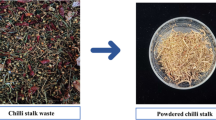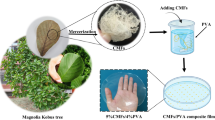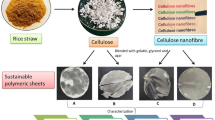Abstract
This study explores the possibility of using Water lettuce (Pistia stratiotes) as a cost-effective substrate for the commercial extraction of cellulose biopolymer using a wide variety of physicochemical treatment methods to compare their efficiency in cellulose extraction. The extraction of cellulose from water lettuce, although promising due to their high cellulose content, was less explored as per the available literature. In this study, functional properties like bulk density-packed density, hydrated density, water retention capacity, oil retention capacity, emulsifying activity and setting volume of the extracted cellulose were studied. The cellulose content from water lettuce was found to be 38.94 ± 0.10% by anthrone method. Preliminary confirmation of cellulose biopolymer was done using the study of functional groups using Fourier Transform Infrared (FT-IR) analysis. Further characterization studies like Scanning Electron Microscopy (SEM), X- Ray Diffraction (XRD), Differential Scanning Calorimetry (DSC) and thermogravimetric analysis (TGA) were conducted to understand the molecular architecture and purity of the cellulose extracted. Fabrication of cellulose sheets was carried out using starch as the plasticizer. Biodegradation studies were conducted in garden soil for four weeks and a high degradation rate of 78.22 ± 0.71% was observed in the fourth week of soil burial.









Similar content being viewed by others
References
Keller RP, Masoodi A, Shackleton RT (2018) The impact of invasive aquatic plants on ecosystem services and human well-being in Wular Lake, India. Reg Envriron Chang 18(3):847–857
Pejchar L, Mooney HA (2009) Invasive species, ecosystem services and human well-being. Trends Ecol Evol 24(9):497–504
Hasanov I, Shanmugam S, Kikas T (2022) Extraction and isolation of lignin from ash tree (Fraxinus exselsior) with protic ionic liquids (PILs). Chemosphere 290:133297
Krumm C, Pfaendtner J, Dauenhauer PJ (2016) Millisecond pulsed films unify the mechanisms of cellulose fragmentation. Chem Mater 28(9):3108–3114
Sassner P, Galbe M, Zacchi G (2008) Techno-economic evaluation of bioethanol production from three different lignocellulosic materials. Biomass Bioenergy 32(5):422–430
Sundari MT, Ramesh A (2012) Isolation and characterization of cellulose nanofibers from the aquatic weed water hyacinth—Eichhornia crassipes. Carbohydr Polym 87(2):1701–1705
Faruk O et al (2012) Biocomposites reinforced with natural fibers: 2000–2010. Prog Polym Sci 37(11):1552–1596
Bao J, Li J (2011) The effect of surface treatment on the mechanical properties of glass fiber reinforced polyamide 6 composite. in Applied Mechanics and Materials. Trans Tech Publ
Kalia S et al (2011) Cellulose-based bio-and nanocomposites: a review. International journal of polymer science, 2011
Karimi S et al (2014) Kenaf bast cellulosic fibers hierarchy: a comprehensive approach from micro to nano. Carbohydr Polym 101:878–885
Majeed K et al (2013) Potential materials for food packaging from nanoclay/natural fibres filled hybrid composites. Mater Design 46:391–410
Alemdar A, Sain M (2008) Biocomposites from wheat straw nanofibers: Morphology, thermal and mechanical properties. Compos Sci Technol 68(2):557–565
Packiam KK et al (2021) Extraction, Purification and Characterization of Nanocrystalline Cellulose from Eichhornia crassipes (Mart.) Solms: A Common Aquatic Weed Water Hyacinth.Journal of Natural Fibers, : p.1–12
Kodituwakku K, Yatawara M (2020) Phytoremediation of industrial sewage sludge with Eichhornia crassipes, Salvinia molesta and Pistia stratiotes in batch fed free water flow constructed wetlands. Bull Environ Contam Toxicol 104(5):627–633
Bhattacharya D, Germinario LT, Winter WT (2008) Isolation, preparation and characterization of cellulose microfibers obtained from bagasse. Carbohydr Polym 73(3):371–377
Wang Z et al (2019) Isolation and characterization of cellulose nanocrystals from pueraria root residue. Int J Biol Macromol 129:1081–1089
Wu J et al (2019) Preparation and characterization of cellulose nanofibrils from coconut coir fibers and their reinforcements in biodegradable composite films. Carbohydr Polym 211:49–56
Ventura-Cruz S, Tecante A (2019) Extraction and characterization of cellulose nanofibers from Rose stems (Rosa spp.). Carbohydr Polym 220:53–59
Reshmy R et al (2021) A green biorefinery platform for cost-effective nanocellulose production: investigation of hydrodynamic properties and biodegradability of thin films. Biomass Convers Biorefinery 11(3):861–870
Reshmy R et al (2021) Development of an eco-friendly biodegradable plastic from jack fruit peel cellulose with different plasticizers and Boswellia serrata as filler. Sci Total Environ 767:144285
Qian C et al (2020) Determination of saccharides in environments using a sulfuric acid-fluorescence approach. Environ Sci Technol 54(11):6632–6638
Gichuki J et al (2022) Characteristics of Microcrystalline Cellulose from Coir Fibers. J Nat Fibers 19(3):915–930
Prakongpan T, Nitithamyong A, Luangpituksa P (2002) Extraction and application of dietary fiber and cellulose from pineapple cores. J Food Sci 67(4):1308–1313
Singanusong R et al (2014) Extraction and properties of cellulose from banana peels. Suranaree J Sci Technol 21(3):201–213
Trilokesh C, Uppuluri KB (2019) Isolation and characterization of cellulose nanocrystals from jackfruit peel. Sci Rep 9(1):1–8
Jonoobi M et al (2009) Chemical composition, crystallinity and thermal degradation of bleached and unbleached kenaf bast (Hibiscus cannabinus) pulp and nanofiber. BioResources 4(2):626–639
Shi J et al (2011) A chemical process for preparing cellulosic fibers hierarchically from kenaf bast fibers. BioResources 6(1):879–890
Zainuddin SYZ et al (2013) Potential of using multiscale kenaf fibers as reinforcing filler in cassava starch-kenaf biocomposites. Carbohydr Polym 92(2):2299–2305
Melikoğlu AY, Bilek SE, Cesur S (2019) Optimum alkaline treatment parameters for the extraction of cellulose and production of cellulose nanocrystals from apple pomace. Carbohydr Polym 215:330–337
Chanda S, Bhaduri SK, Sardar D (1991) Chemical characterization of pressed fibrous residues of four aquatic weeds. Aquat Bot 42(1):81–85
Lu P, Hsieh Y-L (2010) Preparation and properties of cellulose nanocrystals: rods, spheres, and network. Carbohydr Polym 82(2):329–336
Luzi F et al (2019) Valorization and extraction of cellulose nanocrystals from North African grass: Ampelodesmos mauritanicus (Diss). Carbohydr Polym 209:328–337
Reddy KO, Guduri B, Rajulu AV (2009) Structural characterization and tensile properties of borassus fruit fibers. J Appl Polym Sci 114(1):603–611
Mandal A, Chakrabarty D (2011) Isolation of nanocellulose from waste sugarcane bagasse (SCB) and its characterization. Carbohydr Polym 86(3):1291–1299
Maheswari CU et al (2012) Extraction and characterization of cellulose microfibrils from agricultural residue–Cocos nucifera L. Biomass Bioenergy 46:555–563
Jmel MA et al (2019) The stranded macroalga Ulva lactuca as a new alternative source of cellulose: Extraction, physicochemical and rheological characterization. J Clean Prod 234:1421–1427
Sain M, Panthapulakkal S (2006) Bioprocess preparation of wheat straw fibers and their characterization. Ind Crops Prod 23(1):1–8
Meng F et al (2019) Extraction and characterization of cellulose nanofibers and nanocrystals from liquefied banana pseudo-stem residue. Compos Part B: Eng 160:341–347
Johar N, Ahmad I, Dufresne A (2012) Extraction, preparation and characterization of cellulose fibres and nanocrystals from rice husk. Ind Crops Prod 37(1):93–99
Elanthikkal S et al (2010) Cellulose microfibres produced from banana plant wastes: Isolation and characterization. Carbohydr Polym 80(3):852–859
Bogolitsyn K et al (2014) Chemical composition of extractives of normal and rotten aspen (Populus tremula) wood. Russ Chem Bull 63(9):2169–2174
Zhang H et al (2020) Extraction and comparison of cellulose nanocrystals from lemon (Citrus limon) seeds using sulfuric acid hydrolysis and oxidation methods. Carbohydr Polym 238:116180
Kale RD, Taye M, Chaudhary B (2019) Extraction and characterization of cellulose single fiber from native Ethiopian Serte (Dracaena steudneri Egler) plant leaf. J Macromolecular Sci Part A 56(9):837–844
Yeng LC, Wahit MU, Othman N (2015) Thermal and flexural properties of regenerated cellulose (RC)/poly (3-hydroxybutyrate)(PHB) biocomposites.Jurnal Teknologi, 75(11)
Szcześniak L, Rachocki A, Tritt-Goc J (2008) Glass transition temperature and thermal decomposition of cellulose powder. Cellulose 15(3):445–451
Picker KM, Hoag SW (2002) Characterization of the thermal properties of microcrystalline cellulose by modulated temperature differential scanning calorimetry. J Pharm Sci 91(2):342–349
Gouda MK, Swellam AE, Omar SH (2001) Production of PHB by a Bacillus megaterium strain using sugarcane molasses and corn steep liquor as sole carbon and nitrogen sources. Microbiol Res 156(3):201–207
Lucas N et al (2008) Polymer biodegradation: Mechanisms and estimation techniques–A review. Chemosphere 73(4):429–442
Zhao G et al (2019) Biodegradable and transparent cellulose film prepared eco-friendly from durian rind for packaging application. Food Packaging and Shelf Life 21:100345
Ai B et al (2021) Biodegradable cellulose film prepared from banana pseudo-stem using an ionic liquid for mango preservation. Front Plant Sci 12:234
Acknowledgements
Authors are indebted to the Department of Life Sciences, CHRIST (Deemed to be University), Bengaluru, Karnataka, India for providing the necessary facilities to execute the planned research work. This project was supported by Researchers Supporting Project number (RSP-2021/283) King Saud University, Riyadh, Saudi Arabia. The authors would like to thank Van Lang University, Vietnam for funding this work.
Author information
Authors and Affiliations
Corresponding author
Ethics declarations
Competing interests:
The authors declare no conflict of interest.
Additional information
Publisher’s Note
Springer Nature remains neutral with regard to jurisdictional claims in published maps and institutional affiliations.
Rights and permissions
About this article
Cite this article
Umesh, M., Santhosh, A.S., Shanmugam, S. et al. Extraction, characterization, and fabrication of cellulose biopolymer sheets from Pistia stratiotes as a biodegradative coating material: an unique strategy for the conversion of invasive weeds into value-added products. J Polym Environ 30, 5057–5068 (2022). https://doi.org/10.1007/s10924-022-02511-4
Accepted:
Published:
Issue Date:
DOI: https://doi.org/10.1007/s10924-022-02511-4




